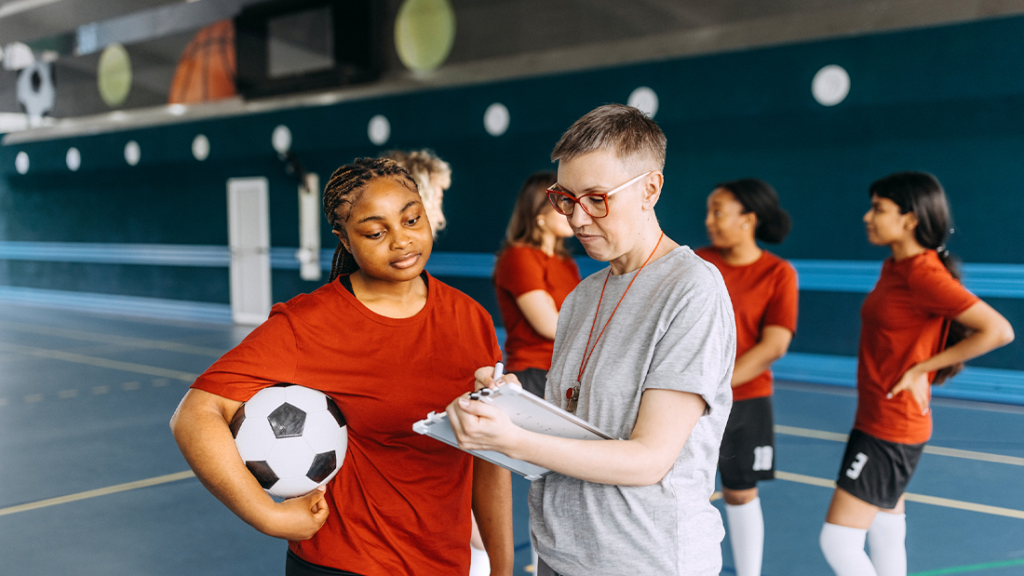When It Comes To Bullying, Coaches Are Positioned To Protect Athletes

Coaches, learn how you can stay aware of bullying behavior, respond to it, and promote a team environment of inclusivity and belonging.
Coaches run practice and draw up game plans. But the job of a coach often extends beyond the pool or the court. They check in regularly to make sure every player on the team is ready to give their all. And they stay behind after the final whistle to ensure each athlete finds a safe ride home.
Some coaches even interact with athletes as a teacher in the classroom or as an administrator, athletic trainer, or community member. Because of their unique role, coaches are positioned to be aware of what’s happening on their team and with their athletes beyond the boundaries of practice. By staying aware of team dynamics wherever athletes gather—during practice and games but also on the bus traveling to an away meet or while athletes are waiting to be picked up after a scrimmage—coaches can address inappropriate behavior early.
Many kids don’t tell an adult when they’ve been bullied. It’s up to the adults around them to observe what’s happening during the time-outs and in the locker rooms. With the right tools and knowledge, coaches can play a key role in recognizing bullying and stepping in if, or when, it occurs.
Stay Aware
Team sports offer kids and adolescents an opportunity to play and grow together. But team environments aren’t always supportive or kind. There’s growing evidence that “a large number of adolescents—particularly female adolescents—struggle with bullying when it comes to sports and physical activity—both in school and within their teams.”
Coaches can reverse this trend. By being aware of the types of bullying behavior that may occur, coaches and sport leaders are better prepared to intervene early if they witness behavior that could escalate into bullying.
Bullying is repeated or severe aggressive behavior directed at someone under age 18. It can be:
- Physical: hitting, beating up, spitting at someone
- Verbal: ridiculing, name-calling, taunting someone
- Social: spreading rumors or lies about someone, socially excluding someone, using technology to harass or frighten someone (cyberbullying)
Keep in mind that addressing even the smallest instances of inappropriate behavior—like teasing or criticizing—could be a useful opportunity to have a conversation with your athletes about the importance of a respectful team environment rooted in inclusivity and belonging.
Respectful Team Environments Win Out
Most coaches can agree that coaching extends beyond the game. After a tough loss, coaches help their players understand how to cope with feelings of disappointment and frustration, often encouraging values like patience and perseverance. In short, coaches help their players develop as both athletes and people.
It’s no secret that coaches have the power to positively shape their team’s culture. Promoting inclusive behaviors that build up others and make them feel welcome is a proven way to prevent bullying and pave the way for your team’s success. Teams that trust and support each other work better together when it matters most.
How Coaches Can Respond
Awareness is the first step to preventing or addressing bullying. The next step is intervening when you witness behavior that is rude, mean, or intended to hurt someone emotionally or physically.
If you witness negative actions or behaviors, like name-calling or intentional shoving:
- Step in and intervene immediately by separating everyone involved.
- Hold athletes accountable for their actions, regardless of their starting position or if they’re a star player.
- Be consistent when responding to misconduct—addressing one incident but ignoring another sends mixed messages about what behaviors are acceptable.
So much of a team’s dynamic is determined by its coach and the way you conduct yourself. Being respectful and modeling kind, appropriate behavior signals to your athletes that you value traits like friendship and good sportsmanship.
Learn more about bullying and how to identify and report it by exploring our Bullying Prevention Handbook for Coaches of Minor Athletes. For more resources, check out our webpage for coaches or visit us at uscenterforsafesport.org.
